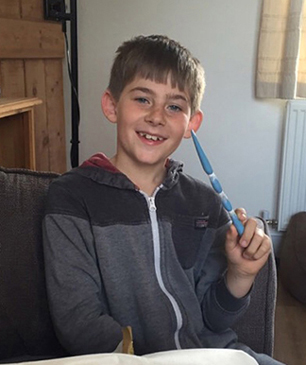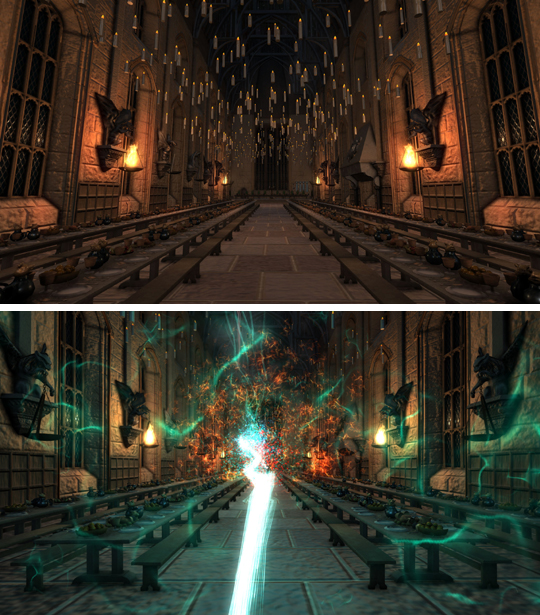 Are you ready to see something stunning, amazing, and totally, wickedly, cool?
Are you ready to see something stunning, amazing, and totally, wickedly, cool?
Above are screen shots from the custom Harry Potter game that was featured at our library’s Wand Works event. Set in the Great Hall of Hogwarts, the Spell Simulator allows kids to test 6 spells with their wands. I’ll share the game with you first, and then introduce you to its creator, Princeton University junior José M Rico (who is, incidentally, majoring in Computer Science and co-founder of the gaming company Kapricorn Media).
For starters, we wanted the game to play on a really big screen, have good sound, and have the highest resolution possible. Instead of cobbling something together with our library’s equipment, I did one of the smartest things of my outreach career. I hired NJ Backyard Movies. They brought a huge inflatable screen, big sound speakers, and a terrific projector. Best of all, a tech guy set everything up and stayed during the event to make sure it ran smoothly.
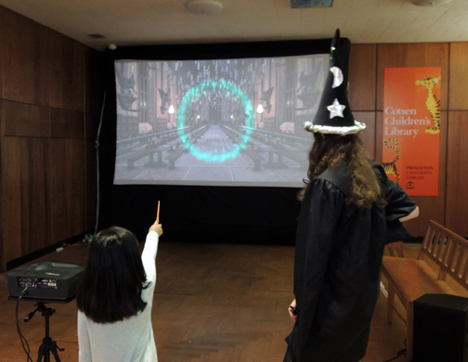 One by one, kids approached the screen, where 6 spells were displayed on a menu – Bombarda, Glacius, Incendio, Lumos Maxima, Priori Incantatem, and Protego. Once chosen, the screen would briefly display the title of the spell, its use, and its linguistic roots. Then the caster would find themselves in the Great Hall. A sparkling circle would appear. With a flick of the wand and a shout, kids would cast the spell.
One by one, kids approached the screen, where 6 spells were displayed on a menu – Bombarda, Glacius, Incendio, Lumos Maxima, Priori Incantatem, and Protego. Once chosen, the screen would briefly display the title of the spell, its use, and its linguistic roots. Then the caster would find themselves in the Great Hall. A sparkling circle would appear. With a flick of the wand and a shout, kids would cast the spell.
Discretely to the side of the spell-casting area, and controlling the game with keystrokes, was José. He wouldn’t activate the spell unless the kids spoke the spell and flicked their wands. And he wouldn’t stop the spell until they raised or lowered their wands. This made the game appear to react to the kids’ movements.
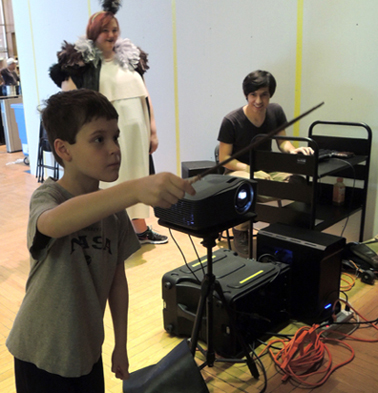 This photo also caught Téa Wimer, our Curator of Muggle Artifacts, taking a break from her exhibit to check out the game. OK. Ready to see the spells? I highly recommend dimming the lights, cranking up the sound, and viewing these full screen.
This photo also caught Téa Wimer, our Curator of Muggle Artifacts, taking a break from her exhibit to check out the game. OK. Ready to see the spells? I highly recommend dimming the lights, cranking up the sound, and viewing these full screen.
AMAZING, right? I must admit, I was moved to tears when José first showed me his game. The amount of time, care, and talent he put into it is truly touching. At the event, there were huge smiles, gasps of wonder, delighted laughter, and long, slow drawn out exclamations of “Whoaaaaaa….”
José has very generously modified the game so YOU can play it. Yup. Download a Windows or Mac version of the game, for free, right here.
GAME DESIGNER JOSÉ M RICO
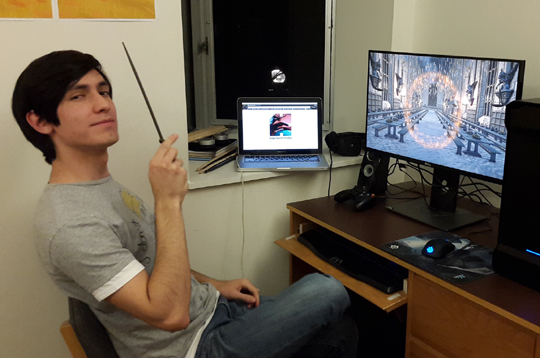
Tell us a little about Kapricorn Media…
Kapricorn Media is a two-man game development team. It consists of Luciano Obregon, the artist and designer and my friend since childhood, and me, the programmer. It was officially named and established by us in May of 2016, though it had inadvertently started in spirit years earlier. Luciano and I have always been searching for something in this world. This has led us on a path of creation, discovery, and uncertainty that involved our early immersions into many LEGO worlds, our wooden sword fights, our hand-drawn mini games, our video game mods, and ultimately our own game development team. Kapricorn Media is our next and most mature step in this constant search.
How would you describe your relationship with the Harry Potter books?
The Harry Potter books opened up a rich universe of magic and adventure. Even though I doubt I was even capable of reading at the time the first book was published, I quickly joined the Harry Potter craze as the movies and the later books started to come out. I spent several days trying to look for the perfectly shaped stick to use as a wand, and then casting spells at my friends and imaginary enemies. I remember Luciano and I made our own Marauder’s Map at some point. I also remember having a framed photo of Luciano and me, only I had cut out a picture of Hermione Granger and pasted it on top of Luciano’s face. I had a huge crush on Hermione.
How did you decide which spells to include in the game?
I started out with a huge list of spells, and a limited amount of time to implement them. Some of them, like Wingardium Leviosa or Accio, would have required me to develop more interactive controls. Some of them weren’t as visually interesting, like Alohomora or Expelliarmus by itself. Ultimately, I chose the ones that I thought were most visually striking and made the caster feel most powerful. I also decided to add Protego and Priori Incantatem to vary the mechanics of the game by introducing an opponent.
Describe the process of building one of the spells…
Each spell had three main components: visual effects, the physical effect of the spell, and sound. I usually implemented them in that order. All visual effects involved some sort of particle system, one or more light sources to integrate the particles with the game scene, and a conduit for the spell, usually a missile or beam. The physical effect of the spell was trickiest for Bombarda, since the explosion triggers an expanding shockwave that knocks back all props in the scene. Finally, the sound design consisted of me shifting through free online sound databases. The explosion sound for Glacius, for example, contains modified audio clips of people dumping out lots of ice cubes.
How long did it take to develop the entire game?
The game probably took me a grand total of 70 to 80 hours to develop.
Which spell is your favorite?
My favorite spell is, by far, Priori Incantatem (which is not technically a spell, but more of an “event”). However, the spell with my favorite sound effects is Glacius.
What was the most creative aspect of this game for you?
The most creative aspect was choosing the appropriate way of presenting and controlling the game environment at the actual event. Even though I experimented with several options, including motion capture through webcams and Nintendo Wii remotes, I ultimately decided to do something extremely simple, yet effective. I was the one controlling the pace of the game behind the scenes. The players would point their wands and cast spells, but it would be me actually pressing the buttons and running the show. As such, the result was more of a visual effects slideshow than an actual interactive game, but I believe it was the best choice for this situation.
What was the most difficult thing to develop?
Even though I developed this game under the name of Kapricorn Media, I was mostly on my own, since Luciano was busy working on his own projects and plans at the moment. Therefore, I had to take over the visual design of the game. I had the good fortune of finding an amazing 3D rendition of the Hogwarts Great Hall by French artist Jeremy Goncalves. This scene grounded the aesthetic of the game and allowed me to take concrete decisions about the scene’s lighting and special effects.
How did event attendees react to your game?
The attendees, both children and parents, were impressed by the power of each spell cast! As the button-presser behind the scenes, I got to watch every single player flick their wand and react at the result. I saw plenty of smiles and surprised faces! There was the occasional skeptic who just shrugged and said “oh, it’s just a screen.” Most players tried one or two spells, though some of them got in line over and over again to try them all. The more attentive and talkative ones approached me and quickly realized that I was, in fact, the one controlling the flow of the game.
Many thanks to artist Jeremy Goncalves for allowing us to use his stunning 3D rendition of the Great Hall.

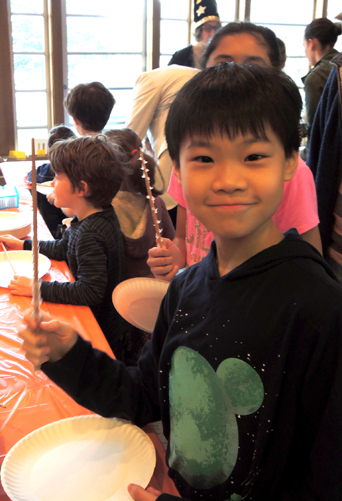 Of everything in the Harry Potter universe, I must admit I find the wands most fascinating. Not just because they play an integral part of spell casting – they also reflect the unique personalities of their owners. Additionally, shouting in Latin is so much more exciting when waving a wand. We tried to capture a little of that magic at Wand Works, our Harry Potter event.
Of everything in the Harry Potter universe, I must admit I find the wands most fascinating. Not just because they play an integral part of spell casting – they also reflect the unique personalities of their owners. Additionally, shouting in Latin is so much more exciting when waving a wand. We tried to capture a little of that magic at Wand Works, our Harry Potter event. Originally, the event was just going to be about wands, wand making, and wand testing. But then I started thinking about the other ways students prepare for Hogwarts. So we brought book bags, text books, and owls into the mix. And, while I’ve recreated an assortment of Hogwarts classes over the years (check out this
Originally, the event was just going to be about wands, wand making, and wand testing. But then I started thinking about the other ways students prepare for Hogwarts. So we brought book bags, text books, and owls into the mix. And, while I’ve recreated an assortment of Hogwarts classes over the years (check out this  That beautiful Accio Books logo was designed by Polly Carlson. You can find it
That beautiful Accio Books logo was designed by Polly Carlson. You can find it 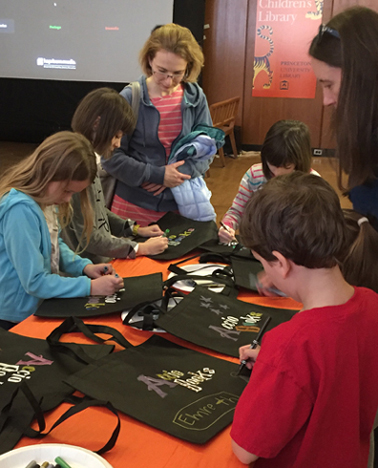 Those are 13.5″ x 14.5″ polypropylene totes from 4Imprint. Specifically, it’s the “Value Polypropylene Tote (item #103873). We tested a couple of polypropylene bags for this project, and 4Imprint’s held the Crayola metallic markers ink beautifully (it smeared on the others). Also, 4Imprint had the best prices and customer service, flat out.
Those are 13.5″ x 14.5″ polypropylene totes from 4Imprint. Specifically, it’s the “Value Polypropylene Tote (item #103873). We tested a couple of polypropylene bags for this project, and 4Imprint’s held the Crayola metallic markers ink beautifully (it smeared on the others). Also, 4Imprint had the best prices and customer service, flat out. Here’s our Flourish & Blotts, staffed by Princeton junior Gabrielle Chen (she’s also the artist behind that fantastic sign)!
Here’s our Flourish & Blotts, staffed by Princeton junior Gabrielle Chen (she’s also the artist behind that fantastic sign)! Behind Gabrielle was a shelf stocked with copies of The Tales of Beedle the Bard, Quidditch Through the Ages, Hogwarts: A Cinematic Yearbook, and the Fantastic Beasts and Where to Find Them screenplay (alas, we missed the release of the text book version of Fantastic Beasts by mere weeks). There were also real quill pens with powdered ink packets, and some adorable Harry Potter Magical Creatures coloring kits.
Behind Gabrielle was a shelf stocked with copies of The Tales of Beedle the Bard, Quidditch Through the Ages, Hogwarts: A Cinematic Yearbook, and the Fantastic Beasts and Where to Find Them screenplay (alas, we missed the release of the text book version of Fantastic Beasts by mere weeks). There were also real quill pens with powdered ink packets, and some adorable Harry Potter Magical Creatures coloring kits. The tickets were color-coded with items on the shelves. Hand in your ticket, and receive the matching item! Just in case you’re wondering, we did sort and distribute the event bags by estimated age of the child. This was to insure that a 4 year-old received a Harry Potter coloring kit, not a copy of Fantastic Beasts.
The tickets were color-coded with items on the shelves. Hand in your ticket, and receive the matching item! Just in case you’re wondering, we did sort and distribute the event bags by estimated age of the child. This was to insure that a 4 year-old received a Harry Potter coloring kit, not a copy of Fantastic Beasts.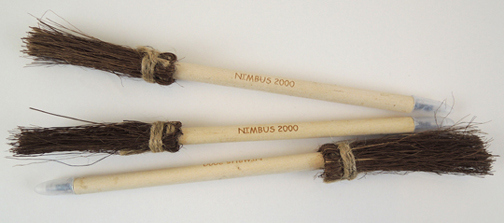 These are “Personalized Witch’s Broom Pens” from Oriental Trading Company ($12 a dozen). For no extra fee, you can customize them with 1 line of text up to 16 characters in length. We went with “Nimbus 2000.” Everyone LOVED them! In fact, the whole table was a lot of fun. It was terrific to see kids, holding books (or quills, or coloring kits, or broom pens) with big grins on their faces.
These are “Personalized Witch’s Broom Pens” from Oriental Trading Company ($12 a dozen). For no extra fee, you can customize them with 1 line of text up to 16 characters in length. We went with “Nimbus 2000.” Everyone LOVED them! In fact, the whole table was a lot of fun. It was terrific to see kids, holding books (or quills, or coloring kits, or broom pens) with big grins on their faces.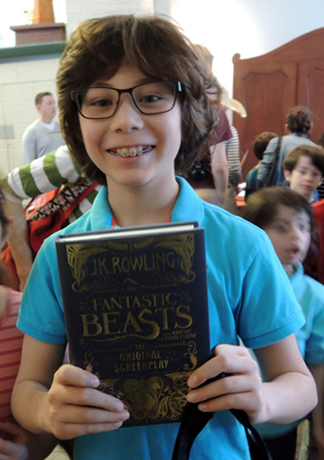 Elsewhere on the event floor was real-life wandmaker Lane O’Neil from Gray Magic Woodworking. You previously met Lane in
Elsewhere on the event floor was real-life wandmaker Lane O’Neil from Gray Magic Woodworking. You previously met Lane in 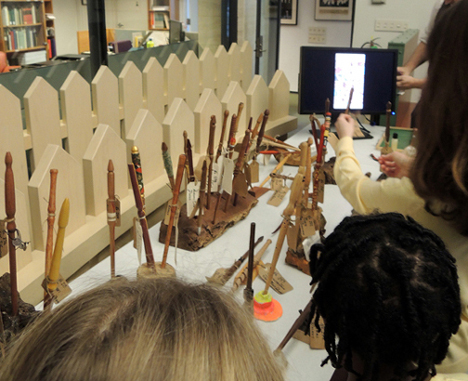 Lane also displayed his lathe, tools, different types of wood, and wands in different stages of completion. He did demonstrations, showed slides, and answered questions throughout the entire event.
Lane also displayed his lathe, tools, different types of wood, and wands in different stages of completion. He did demonstrations, showed slides, and answered questions throughout the entire event.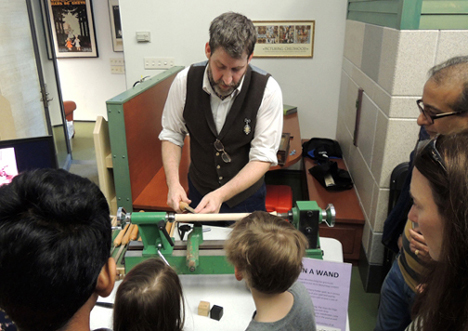 Not far from Lane was our Muggle Artifact exhibit, curated by Princeton University sophomore Téa Wimer. The exhibit consisted of 45 Muggle objects complete with informative exhibit labels. Below, two attendees ponder a Cookie Slicer (which, amazingly, looks just like an old school photo enlarger).
Not far from Lane was our Muggle Artifact exhibit, curated by Princeton University sophomore Téa Wimer. The exhibit consisted of 45 Muggle objects complete with informative exhibit labels. Below, two attendees ponder a Cookie Slicer (which, amazingly, looks just like an old school photo enlarger).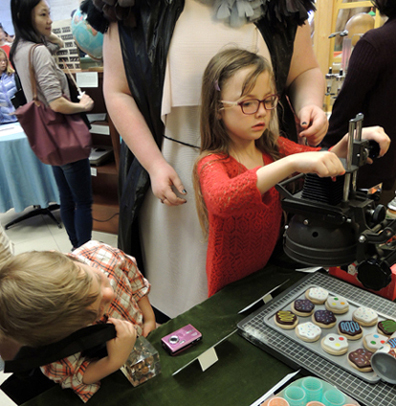 And here, two scholars consider a World Checker. Nearby is a rather puzzling object on a pedestal. Kids could write guesses as to what the Muggles use the object for. The full exhibit, as well as an interview with Curator Téa Wimer, is now
And here, two scholars consider a World Checker. Nearby is a rather puzzling object on a pedestal. Kids could write guesses as to what the Muggles use the object for. The full exhibit, as well as an interview with Curator Téa Wimer, is now  Owls are another must for Hogwarts students, so we had a table where kids could make these awesome and super simple
Owls are another must for Hogwarts students, so we had a table where kids could make these awesome and super simple 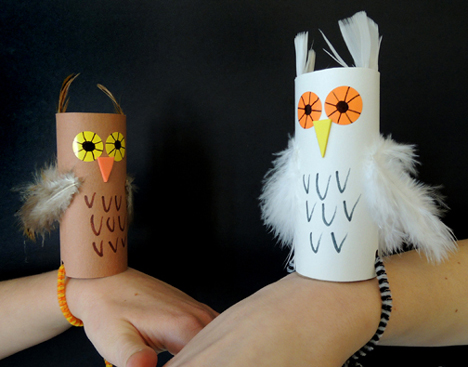 And now we come to the main event – THE WANDS. After much searching and testing, we settled on wands made from cooking chopsticks, hot glue, and paint. They are, in fact, very much like the wands our kid tester made for her
And now we come to the main event – THE WANDS. After much searching and testing, we settled on wands made from cooking chopsticks, hot glue, and paint. They are, in fact, very much like the wands our kid tester made for her  For the event, we made trays out of box lids, separating the wands into blunt and pointy sections. This was primarily for the benefit of parents and caretakers. The pointy chopsticks were definitely the most popular, but we also had many adults who were very grateful for the blunt wands. There was even some quietly-switch-from-pointy-to-blunt-while-the-kid-is-distracted going on.
For the event, we made trays out of box lids, separating the wands into blunt and pointy sections. This was primarily for the benefit of parents and caretakers. The pointy chopsticks were definitely the most popular, but we also had many adults who were very grateful for the blunt wands. There was even some quietly-switch-from-pointy-to-blunt-while-the-kid-is-distracted going on.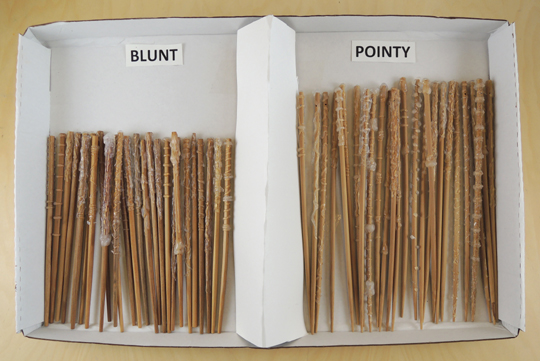 Next came the hot glue. While we would have loved for kids to make their own hot glue designs at the event, we knew that just wasn’t possible on a large scale. So we hot glued all the wands in advance. It took us a couple months of chipping away here and there, but in the end we had hundreds of wands, and no two were alike.
Next came the hot glue. While we would have loved for kids to make their own hot glue designs at the event, we knew that just wasn’t possible on a large scale. So we hot glued all the wands in advance. It took us a couple months of chipping away here and there, but in the end we had hundreds of wands, and no two were alike. Next, the paint! After testing a number of different paints, we settled on Michaels Craft’s in-store brand, CraftSmart. We used their satin acrylic paint because it was water-based, non-toxic, fast-drying, and there were lots of different shades of brown. The regular acrylic paint was too dull, but the satin left a really nice finish on the wand.
Next, the paint! After testing a number of different paints, we settled on Michaels Craft’s in-store brand, CraftSmart. We used their satin acrylic paint because it was water-based, non-toxic, fast-drying, and there were lots of different shades of brown. The regular acrylic paint was too dull, but the satin left a really nice finish on the wand.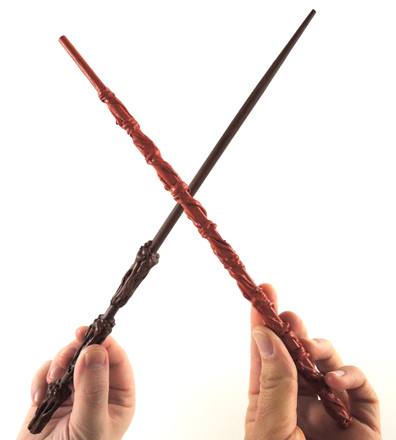 At the event, kids selected the wand they liked from the tray, and then picked the paint color they wanted. To make the color selection easier, we made several paint choice panels out of
At the event, kids selected the wand they liked from the tray, and then picked the paint color they wanted. To make the color selection easier, we made several paint choice panels out of 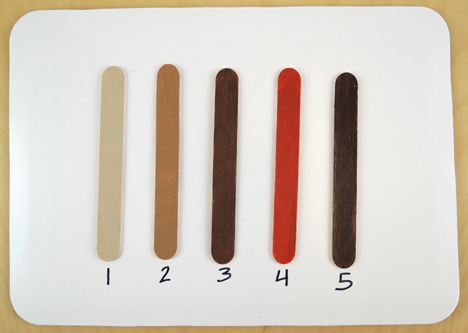 From left to right, the CraftSmart satin acrylic paint colors are khaki, golden brown, brown, burnt orange, and espresso. Burnt orange and espresso were definitely the most popular. But all the colors looked fantastic.
From left to right, the CraftSmart satin acrylic paint colors are khaki, golden brown, brown, burnt orange, and espresso. Burnt orange and espresso were definitely the most popular. But all the colors looked fantastic.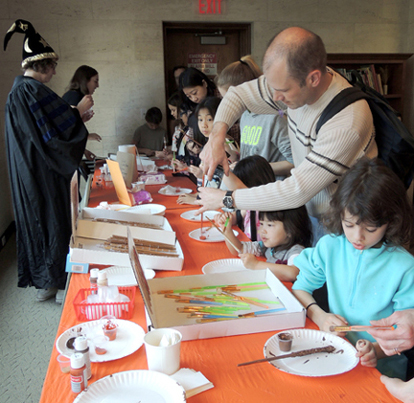 This paint was extremely fast drying on the wood, even with multiple coats. The hot glue, however, was another story. In order to dry the wands faster, we put together a wand-drying chamber out of a piece of cardboard, jumbo binder clips held down with packing tape, and 2 box fans running on low.
This paint was extremely fast drying on the wood, even with multiple coats. The hot glue, however, was another story. In order to dry the wands faster, we put together a wand-drying chamber out of a piece of cardboard, jumbo binder clips held down with packing tape, and 2 box fans running on low.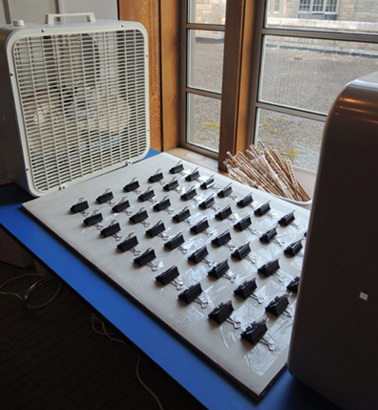 Below you can see the wand drying chamber in action, with the wands inserted in the clips. At the event, kids wrote their names on little bits of paper, which were clipped with the corresponding wands. Depending on how many coats of paint were on the wand, it typically took 5 – 10 minutes for a wand to dry in the chamber (15 if there was a LOT of paint).
Below you can see the wand drying chamber in action, with the wands inserted in the clips. At the event, kids wrote their names on little bits of paper, which were clipped with the corresponding wands. Depending on how many coats of paint were on the wand, it typically took 5 – 10 minutes for a wand to dry in the chamber (15 if there was a LOT of paint).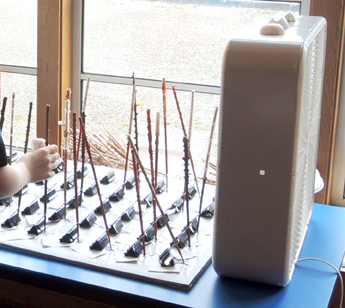 To be clear – the wand drying chamber was tucked behind the event tables, away from the crowds. Only event staff had access to it for obvious reasons. However, if I was to do this event again, I would definitely add a designated “Wand Pick-Up Area” to make things run even more smoothly.
To be clear – the wand drying chamber was tucked behind the event tables, away from the crowds. Only event staff had access to it for obvious reasons. However, if I was to do this event again, I would definitely add a designated “Wand Pick-Up Area” to make things run even more smoothly.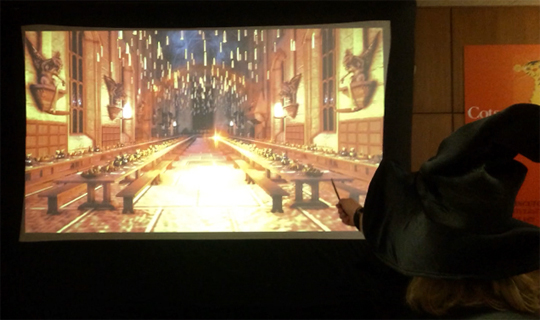 All the details of the game, as well as video and a free download, can be found
All the details of the game, as well as video and a free download, can be found 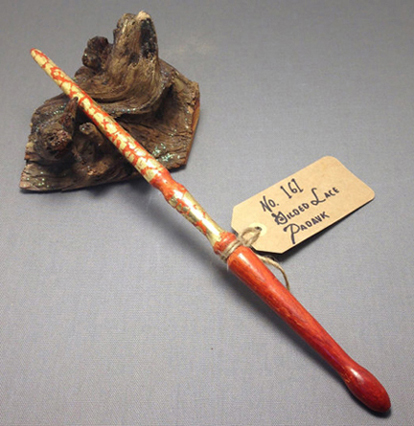 Does the wizard choose the wand? Or does the wand choose the wizard?
Does the wizard choose the wand? Or does the wand choose the wizard?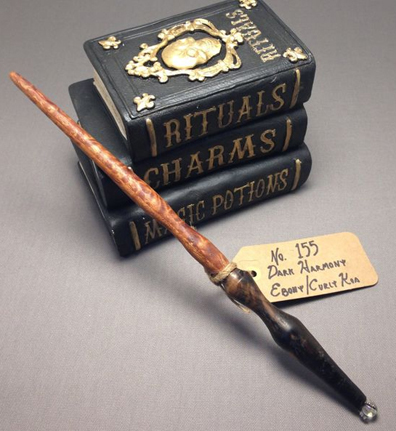 Fantastically, Lane donated 3 of his wands to our Accio Wand blog contest! Readers of all ages were invited to submit an original Harry Potter spell, be it silly or serious. The winning entries are posted
Fantastically, Lane donated 3 of his wands to our Accio Wand blog contest! Readers of all ages were invited to submit an original Harry Potter spell, be it silly or serious. The winning entries are posted 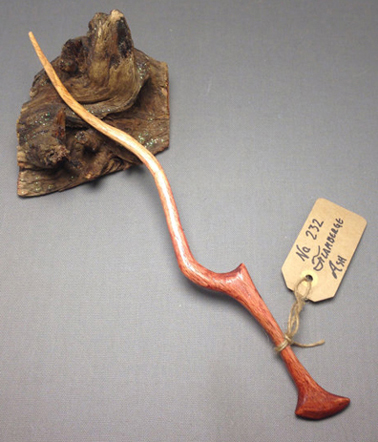 What sorts of woods do you use?
What sorts of woods do you use? Where do you acquire the wood for your wands?
Where do you acquire the wood for your wands?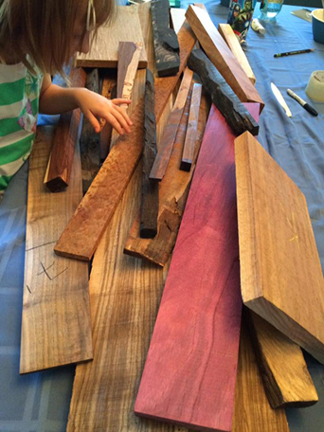 My favorite place is called Hearn, they are located in Oxford, PA. It’s like a candy store for people who craft wood. They have everything from domestic scraps to 16′ slabs of exotic wood shipped from the hearts of far away continents.
My favorite place is called Hearn, they are located in Oxford, PA. It’s like a candy store for people who craft wood. They have everything from domestic scraps to 16′ slabs of exotic wood shipped from the hearts of far away continents.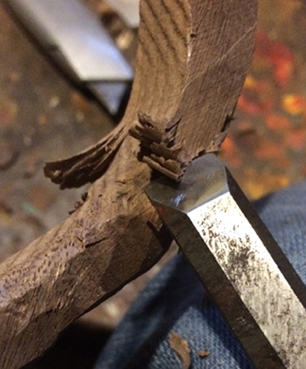 When it’s just about fully shaped, I use sandpaper to smooth it – working to smaller grits until I’m happy with the texture. I can also stain or paint the wand while it’s spinning. I usually use a carnauba wax/ tung oil blend to finish fully.
When it’s just about fully shaped, I use sandpaper to smooth it – working to smaller grits until I’m happy with the texture. I can also stain or paint the wand while it’s spinning. I usually use a carnauba wax/ tung oil blend to finish fully. When I’m just about done, I “part” the wand from the lathe by cutting the material away by the tip or pommel until the wand falls off. I move the piece to the work bench, saw the remaining scrap block off, sand the two rough ends, and finish with carving, wood burning, or other decorations. I tag it, give it a name, and a number.
When I’m just about done, I “part” the wand from the lathe by cutting the material away by the tip or pommel until the wand falls off. I move the piece to the work bench, saw the remaining scrap block off, sand the two rough ends, and finish with carving, wood burning, or other decorations. I tag it, give it a name, and a number. How long does it take to make a wand?
How long does it take to make a wand?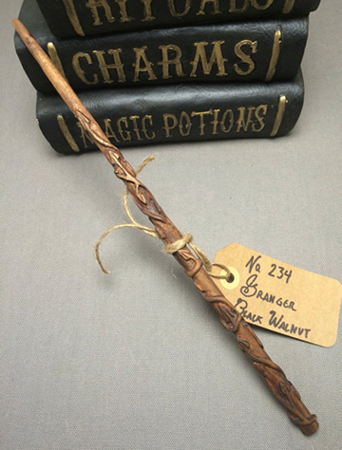 What locations have your wands shipped to?
What locations have your wands shipped to?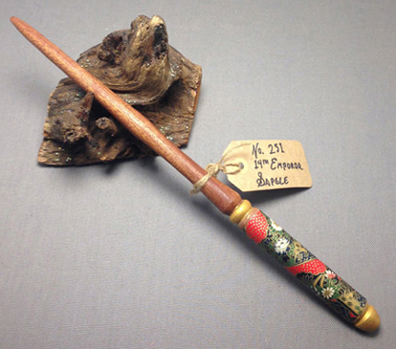 What’s the most unusual or significant wand you’ve ever made?
What’s the most unusual or significant wand you’ve ever made?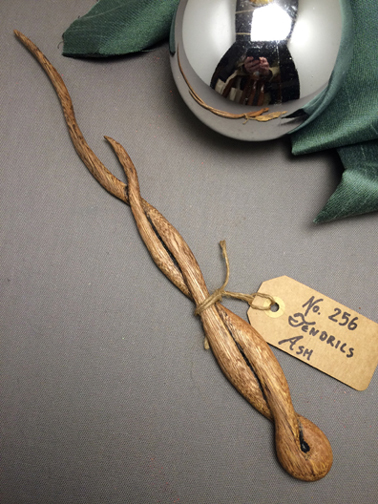 The most significant wand I’ve ever made is a tie. I made a Beech wand that was chosen by a young girl from the Make-A-Wish Foundation. There wasn’t anything too special about it other than the leather wrapped handle, but she chose it.
The most significant wand I’ve ever made is a tie. I made a Beech wand that was chosen by a young girl from the Make-A-Wish Foundation. There wasn’t anything too special about it other than the leather wrapped handle, but she chose it.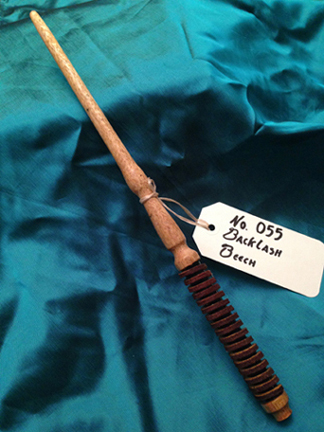 The other one was purchased by a mother in London, England. She bought a Japanese Maple for her son Harry for his 10th birthday…that was pretty cool. His mother sent me a photo.
The other one was purchased by a mother in London, England. She bought a Japanese Maple for her son Harry for his 10th birthday…that was pretty cool. His mother sent me a photo.